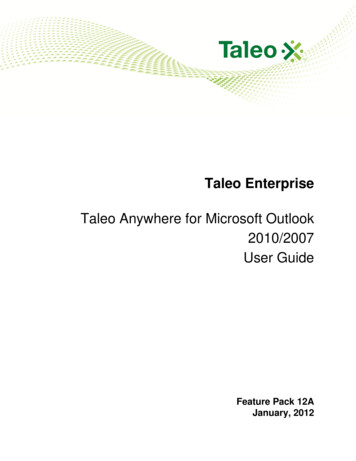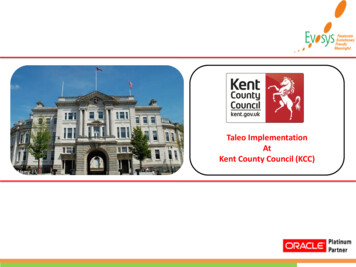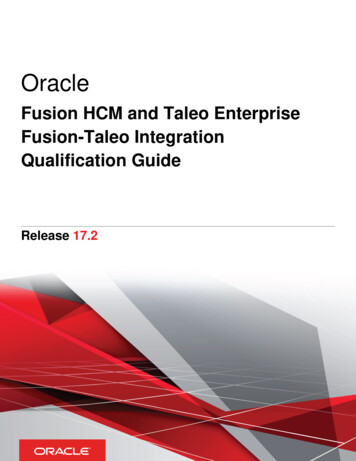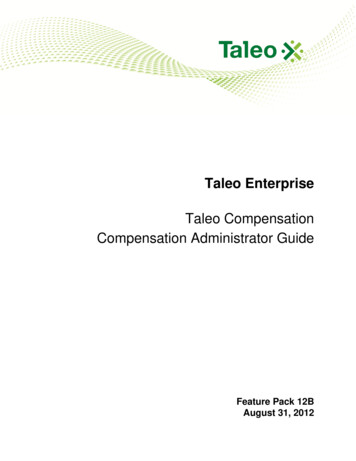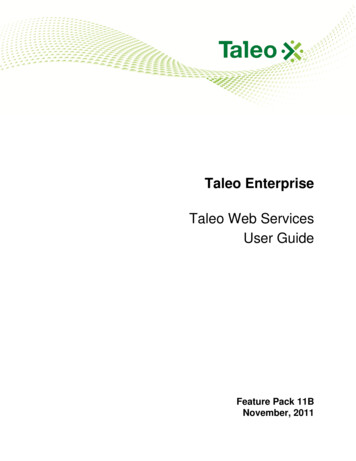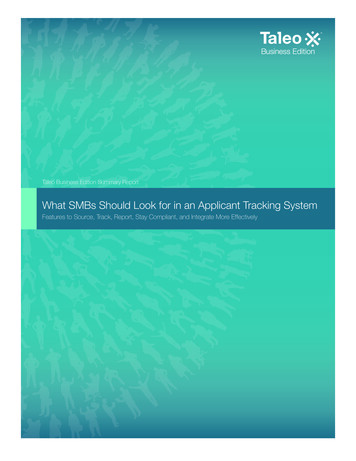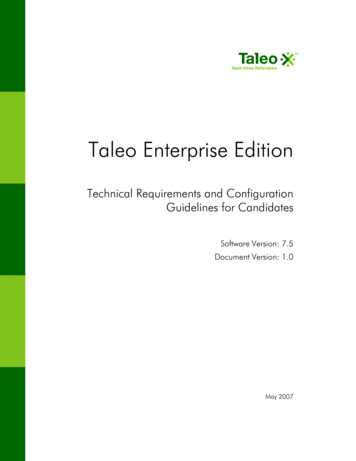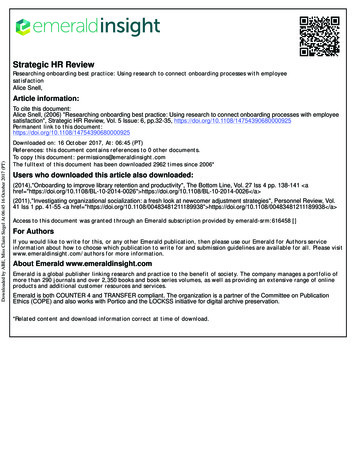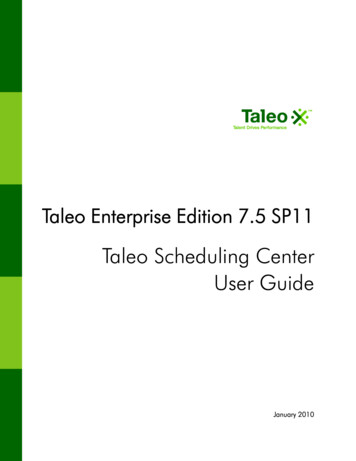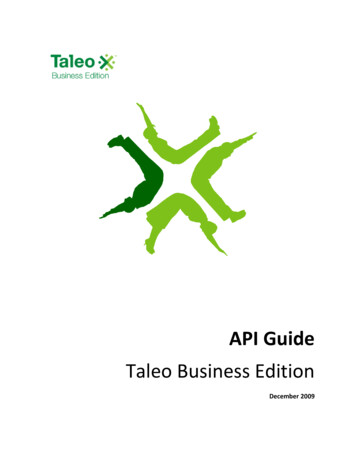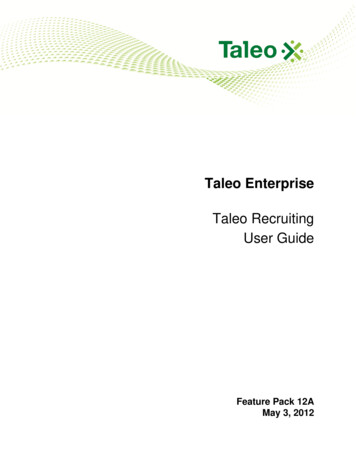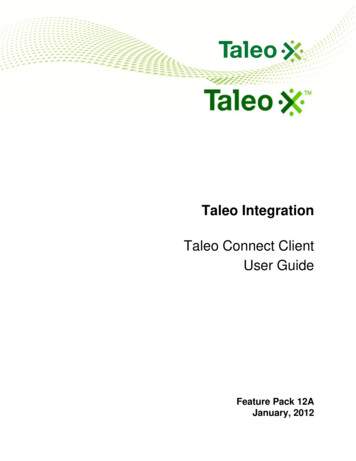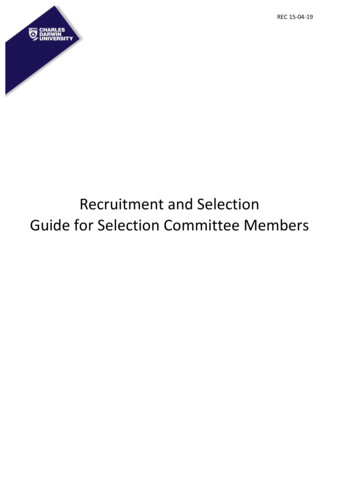
Transcription
REC 15-04-19Recruitment and SelectionGuide for Selection Committee Members
Recruitment and Selection Guide for Selection Committee MembersContentsIntroduction . 3Merit Principle . 3Selection Committee. 3Composition . 3Responsibilities of the Selection Committee . 4The role of the Chair . 4The role of the Selection Committee . 4The role of the HR Client Services Team . 4Shortlisting . 4Selection Techniques . 5Interview Preparation . 6Planning . 6Selecting Interview Questions . 7Contacting applicants. 7Preparing the Venue . 7Conducting the Interview . 8Cancellation of Interview . 8Conducting Referee Checks . 8Reaching Agreement . 9Offer . 9Discussing the offer. 9Offer of Employment . 9Offer of Employment declined. 9Notifying unsuccessful candidates . 10Appeals and grievances . 10Appendix . 11Selection Committee Checklist . 11Delegation. . 12Page 2 of 13
Recruitment and Selection Guide for Selection Committee MembersIntroductionThe appointment of Fixed-term and Continuing staff at Charles Darwin University is conducted via amerit based selection process. This process is often supported based on the recommendations of aSelection Committee. Committee members are responsible for assessing the merit of each applicantand making their recommendation of the most suitable applicant to the Chair.The purpose of the Selection Committee Guide is to provide committee members with relevantinformation about those aspects of the selection process they are primarily involved in, such asshortlisting, interview, reference checking and decision making.Merit PrincipleThe merit principle used throughout the selection process is required to demonstrate the al Justice:The process used for assessment must be clear and transparent.The Selection Committee must be impartial, free of any conflict of interest,and base their recommendations on demonstrated evidence of theapplicants’ competency against the selection criteria.The assessment process is reasonable, applied fairly and consistently to allcandidates.Where adverse information on an applicant is received, the applicantshould be afforded natural justice to respond before a final decision ismade.Selection CommitteeThe Selection Committee is included in conducting an assessment process which ensures theapplicants’ suitability, considering knowledge, skills, qualifications and experience, and potential forfuture development is considered against the specific requirements of the position as outlined in theselection criteria. The Selection Committee should have the appropriate level and range of expertiseto assess the skills and attributes required of the position.CompositionChair: The Hiring Manager or nominee takes on the responsibility of the Chair of the SelectionCommittee. They are the primary contact for candidates and actioning tasks in TalentAcquisition. It is preferable that the Chairperson has undertaken merit based recruitmentand selection training. For details on training contact the Organisational Capability Unit inOPC.Membership: The Selection Committee is chosen to suit the circumstance of the vacancy and thebusiness environment in which it operates. The Committee should consist of between two tofive members with the necessary expertise and knowledge to make a competent assessmentof the applicants. Members should understand the principles of Merit based selection, EqualEmployment Opportunity, Unconscious Bias and Natural Justice.It is recommended the committee composition includes: Members of senior or equal classification to the position being interviewed;Gender representation;Representation external to the area; andIndigenous representative is mandatory if an identified Indigenous applicant is beinginterviewed.Page 3 of 13
Recruitment and Selection Guide for Selection Committee MembersResponsibilities of the Selection CommitteeThe role of the ChairThe Chair of the Selection Committee has a lead role in the selection process and determines thesize and composition of the Selection Committee based on the nature of the appointment and theexpertise needed to make a sound selection recommendation.The Chair facilitates the recruitment process ensuring committee members understand theirobligations, are aware of the need to avoid conflict of interest and have access to the candidate’sapplications. The Chair will draft relevant interview questions for the selection committee to reviewand ensure the selection process complies with legislative requirements. Upon completion, the Chairwill ensure all documentation is uploaded into Talent Acquisition. They will also be responsible forupdate candidate selection and listing according to suitability.The role of the Selection CommitteeUnder the direction of the Chair, the Selection Committee undertakes a number of roles throughoutthe selection process. They can assist with determining the selection methodology, developinginterview questions, shortlisting preferred candidates, however predominantly partake ininterviewing and conducting referee checks.Committee members ensure the Merit Principle is applied throughout the process; applicants areassessed fairly and equitably, and determine the most suitable applicant is recommended forappointment.Committee members must notify the Chair of any potential conflict of interest between themselvesand an applicant. The Chair shall determine whether a conflict of interest exists and, if so, allow theperson to withdraw from the Selection Committee.Where a committee member is away ill or needs to withdraw from the committee, the Chair willdecide if a replacement is required or not.The role of the Talent Acquisition and Global Mobility (TA&GM) TeamThe TA & GMTeam are available throughout the process in a support capacity. They providerecruitment advice and Taleo support for all vacancies, whether internal or external.The TA & GM Team will also, assist with troubleshooting for Taleo problems and provide generalrecruitment and employment advice.It’s important to note that the TA & GM Team are available in a support capacity, however will notcomplete the recruitment process for the Hiring Manager.ShortlistingShortlisting of applications is the initial stage of the assessment process. Where there have beenover 20 applications for a particular role the Chair should review and make a first shortlist draft.Where possible the Chair should avoid giving the Selection Committee a list greater than 20.Applicants should have the right to work in Australia as determined by the Department ofImmigration and Citizenship however, CDU does offer sponsorship for select applicants. You shouldspeak with the Talent Acquisition and Global Mobility Team if you are considering applicants who donot currently hold working rights.Page 4 of 13
Recruitment and Selection Guide for Selection Committee MembersThe shortlisting process identifies those applicants who provided demonstrated evidence that bestsmeet the requirements of the role. This can be in the form of; a detailed cover letter, resume,qualifications, relevant experience, statement of claim, and work or skill testimonials.Addressing the selection criteria is no longer an essential requirement for responding to Universityvacancies. The process is considered tedious and may deter some highly skilled but time poorapplicants from applying. Committee members are advised to review the career history of theapplicants to ascertain if they have the relevant skills; experience, knowledge and qualifications tobe successful in the role.Where a statement of claims against the selection criteria is required the Chair will request for it beincluded in the advertising text.Late applications may be accepted at the discretion of the Chair, prior to the commencement of theinterview process.Note: It is not necessary for the Selection Committee to shortlist every applicant that meets thecriteria of the role. It is considered best practice that no more than 5 applicants be shortlisted forinterview.Shortlisting meetingWhere there is 3 or more Committee members it is recommended the Chair holds a meetingbetween the members. In preparation, the Chair ensures the members have the necessaryinformation to make an informed decision including a copy of the Position Profile and advertisingtext.This meeting should determine: Candidates to progress for interview. Candidates should be rated as either Competitiveor Non-Competitive;Review the interview questions selected by the Chair;Allocate dates and location for interviews;Establish if phone or video conference interviews are required for candidates unable toattend an initial interview on Campus;Identify work tasks or presentations that will form part of the interview process.Selection TechniquesSelection techniques are designed to provide applicants with the best opportunity to demonstratetheir skills or provide evidence supporting their ability to meet the selection criteria. As a minimum,it is recommended that the following selection techniques are included in the selection process.InterviewsA structured interview is the most commonly used selection technique to identify a recommendedcandidate as it allows the selection committee to assess the applicants’ competencies against theselection criteria. Interviews are best held in person, however, due to the geographical location ofthe applicant the initial interview may be conducted by phone or video conference.Interviews should include behavioural style questions relevant to the selection criteria andsupported by probing questions to uncover the applicants past performance or response to asituation.Page 5 of 13
Recruitment and Selection Guide for Selection Committee MembersWork Samples / Skill TestApplicants may be requested to provide samples of their own work, such as an article or case studydemonstrating their creative writing ability or in the case of an academic delivering a lecture ordemonstration their ability to apply for grants.PresentationsA presentation on a predetermined topic at the time of interview can produce an insight into theapplicant’s ability to communicate professionally.Psychometric TestingThis is recommended for use on senior vacancies or specialised positions only. The 4 types of teststypically used in the selection process are; personality, cognitive ability, work styles and motivation.Due to the complexity and specialisation involved in conducting and analysing psychrometric tests, itis recommended this is outsourced to an approved supplier. Details on recommended providers canbe provided by Talent Acquisition and Global Mobility.Reference ChecksA well conducted verbal reference with the candidate’s most recent supervisors or line manager willprovide confirmation of their previous employment and level of experience, as well as helping theSelection Committee assess the candidate’s ability to perform in the new role. Referees may becontacted more than once in relation to an applicant’s claims if the Committee deems it appropriate.Interview PreparationPlanningIt is important for the Selection Committee to formulate an effective interview plan. Interviewsshould be scheduled to allow sufficient time between interviews to ensure applicants do not meeteach other in the cross over and appropriate time for the Selection Committee to discuss theirfindings and select a recommended candidate. It is also important for members to consider culturalsensitivities and any special needs identified by the applicant being interviewed.The Committee should meet at least 15 minutes prior to the interview to ensure they are clear onthe information required and the lines of questioning to get the required outcomes.Page 6 of 13
Recruitment and Selection Guide for Selection Committee MembersSelecting Interview QuestionsThe Chair and the Selection Committee should agree on a set of questions that test the candidate’sskills, knowledge, competencies, previous experience, and understanding of the requirements of theposition.In preparing questions, the Committee should focus on selecting behaviourally-oriented questionthat will demonstrate through past behaviour the applicants’ ability to meet the selection criteria.One technique for creating behavioural interview questions is the STAR approach.STARExamplesSituation or Task questions Action questions Result questionsTell us about a time whenDescribe a situation whenWhat were the circumstancessurroundingExactly what did you do?Describe specifically how you did that.Walk us through the steps you tookWhat was the result?How did that work out?What feedback did you receive?If the interview process involves candidates making a presentation or preparing a response to aquestion in advance, ample notice should be given to each candidate prior to the interview (at least48 hours’ notice).If the Selection Committee elects to provide the interview questions to applicants it is recommendedthey are provided at the same time to each candidate. Ideally, no more than 15 minutes before theinterview.Contacting applicantsThe Chair of the Selection Committee is responsible for contacting shortlisted candidates to scheduleinterviews. This is an opportunity for the Chair to speak with candidates to establish rapport andconfirm if they have any specific requirements for the interview, i.e. disability access or visual orhearing assistance, video conferencing technology (Zoom WebEx). The chair should then send aconfirmation of the scheduled interview time to the candidate.It is recommended applicants are given at least 48 hours notice of the interview and are providedclear directions as to where and when the interview will take place. For applications beinginterviewed via video conferencing, it is recommended the technology link is confirmed and a trialrun conducted prior to interview.Preparing the Venue Choose a comfortable and private room with adequate lightingRemove any visible or audible distractionsEnsure good seating arrangementsConsider the location of seating for candidates with a known hearing, sight or a physicaldisabilityTest video conferencing technologyProvide clean glasses and fresh waterPage 7 of 13
Recruitment and Selection Guide for Selection Committee Members Ensure that the candidates will not encounter other candidates on arrival or exitConducting the InterviewSuccessful interviews allow information flow between the candidate and Selection Committeemembers. It is important to establish an open and friendly rapport with the candidate as soon aspossible to assist them to overcome any anxiety or nervousness they may be experiencing.The Chair should: Greet the candidate on arrivalIntroduce the Selection CommitteeAdvise the candidate of the structure of the interview and its expected durationProvide a very brief overview of the University, the position and the work areaAsk the candidate if they are ready to proceedTo ensure consistency and fairness, committee members should share the task of asking the agreedquestions to all candidates. Follow up or probing questions are acceptable if further information isrequired. The Committee should also invite questions from the candidateThe Chair should confirm referee contact details, thank the candidate for their interest in applyingfor employment at the University and advise them when they should expect to hear back from theCommittee. Committee members may use the Interview Assessment Form to record candidateresponses during each interview. This worksheet can then be referred to during group discussion.Cancellation of InterviewWhere possible the Selection Committee will facilitate re-scheduling the interview if an applicant isunable to attend. Where an applicant continues to cancel or request a reschedule, the SelectionCommittee may elect to remove the applicant from the selection process. In such case the Chair ofthe Selection Committee will formally advise the applicant in writing.Conducting Referee ChecksReferences are a critical component of the selection process. A well conducted verbal reference withthe candidate’s most recent supervisors or Manager will provide confirmation of their previousemployment and level of experience, as well as helping the Selection Committee assess thecandidate’s ability to perform in the new role.The Committee should discuss and agree on who will complete referee checks. In most, if not allcases, this will be the Chair or Line Manager.Referees should be formally advised that the information provided will be documented and theapplicant may request to view the report. Should a referee decline to provide a reference, then theChair can elect to request an alternative referee.It is recommended that two verbal references be obtained for an external applicant, while one checkis required for an internal applicant, and should include the candidate’s most recent Supervisor. Ifthe candidate does not want their current Supervisor to be contacted, try and attain a secondarychoice in lieu. In the event of an adverse reference, the candidate should be offered a right of replyto ensure natural justice.A written record detailing the nature of verbal referee checks must be completed on the VerbalReference Check form and uploaded into Taleo.Page 8 of 13
Recruitment and Selection Guide for Selection Committee MembersReaching AgreementThe Talent Acquisition Interview Assessment Summary form is the official record of the selectionprocess used by the panel to reach its recommendation. This is uploaded and attached to Taleo. Thisdocument can later be used for auditing recruitment processes conducted, as evidence if necessaryto show fair appointment decisions and confirms the Selection Committee followed due diligence inthe selection process.In making its decision the Selection Committee should evaluate all relevant information (application,interview, exercise/task/presentation and referee checks) in order to recommend the most suitablecandidate.Candidates who have undergone the interview process should be identified as either appointable ornon-appointable to the position. To highlight this in Talent Acquisition the chair should update thecandidate and use the ranking of 1 5, with 1 indicating preferred candidate. This may assist withlater appointments of a similar level within the University.Differences of opinion within the Committee should be seen as both natural and helpful rather thana hindrance in decision making. Generally, differences in opinion will result in more thoroughconsideration of all information.Committee members should not feel compelled to change their minds simply to avoid conflict orreach agreement. If agreement cannot be reached on the most suitable candidate, there are anumber of alternative courses of action such as follow up interviews, additional referee informationand submission of a minority report as part of the Chair’s recommendation for appointment. Contactthe Talent Acquisition and Global Mobility team for assistance with this process.The Chair of the Selection Committee is responsible for completing and submitting the TalentAcquisition Interview Assessment Summary form.OfferDiscussing the offerThe Chair of the Selection committee may advise the top candidate they are the preferred candidateand discuss salary expectations and availability; however, it must be clear an offer of employment isissued by the Office of People and Capability (OPC).Offer of EmploymentThe official offer of employment comes in the form of a Contract of Employment provided by Peopleand Capability. If negotiations are made outside the advertised position, the Chair must seekguidance from the relevant Talent Acquisition and Global Mobility team member and may berequired to reconfirm their recruitment and budget approvals. This should be done before movingthe candidate to offer with P&C.Offer of Employment declinedWhere an applicant declines the offer of employment the Chair with the support of the Committeemay engage with the second placed appointable candidate. Should there not be any other applicantappointable then the Chair may elect to return to market or postpone the process to a moreappropriate time.Page 9 of 13
Recruitment and Selection Guide for Selection Committee MembersNotifying unsuccessful candidatesUpon acceptance of a formal, written offer by the recommended candidate the Chair can contactthe unsuccessful candidates by phone.It is encouraged that the chair provides feedback to the unsuccessful candidates should they ask.The feedback should be constructive, factual and fair, and if appropriate, encourage them to applyagain in the event of other opportunities. This can be a difficult conversation to approach. It isrecommended the Chair thanks the candidate for their interest and time, stresses the positiveattributes of the application and interview, and provides advice on how the candidate could haveperformed better or how they related to the successful candidate.Appeals and grievancesRecruitment and Selection outcomes are not subject to an appeal process.An internal employee who is unsuccessful in their application for appointment to a position of morethan 12 months duration may lodge an appeal if they believe there was a breach in the recruitmentand selection process or a conflict of interest was not declared.Appeals must be lodged with the Director, People and Capability within 3 working days of beingnotified.The Director, People and Capability will ensure the claim is investigated and a written decision isprovided within 10 working days of lodgement of the appeal.Page 10 of 13
Recruitment and Selection Guide for Selection Committee MembersAppendixSelection Committee ChecklistChairCommittee TaskCompetitive based interviewConvene a Selection Committee appropriate in size to the position.Draft behavioural oriented questions for the Selection Committee to review.Provide the Selection Committee with a copy of the Position Profile andAdvertisement.Check for any perceived conflict of interest.Short-listing ProcessEnsures the Selection Committee members understand their roles andresponsibilities in the short-listing and interview process.Chair and Committee members have hard copies of the applications or access tothem online.Chair and Committee meet to compare each preliminary short-list and reach aconsensus on: Candidates to be interviewed. Questions that may be asked at the interview. Suitability of phone or video conferencing interviews for interstate orinternational candidates. Any tasks or presentations that will form part of the interview process. Date, time and location of interviews. Organises venue and any other requirements for interviews. Contacts candidates to arrange interview. (give at least 48 hours notice). Send confirmation of interview time and venue by email. Advise candidate ifpresentation / assessment will be required at interview.The Chair is responsible for updating those unsuccessful candidates (not chosen forinterview). Taleo will assist generating a pre-set email to advise them.Interviewing Conducts interviews using the Interview Assessment form.Post-InterviewThe Chair arranges for referee checks to be completed using the Verbal ReferenceGuide and Verbal Reference Check form.Committee’s Talent Acquisition Interview Assessment Summary report to besubmitted with appropriate verbal reference checks to the Talent Acquisition &Global Mobility team.If Applicable – discuss with the Talent Acquisition and Global Mobility Team what isrequired if the preferred candidate requires arrangements with relocation or Visasupport.If Applicable – discuss the preferred candidate with Senior Executive or HoS. Discusssalary expectations and possible start date with the recommended candidate.Chair is responsible for updating those unsuccessful candidates (chosen forinterview).On BoardingEnsures that workstation / office is ready for the successful candidate’s start date.Contacts the successful candidate prior to their start date to ensure they knowwhere to go when they arrive on their first day and who to ask for if appropriate.Ensures a date has been scheduled for New Starters Compulsory Orientation /Induction.Page 11 of 13
Recruitment and Selection Guide for Selection Committee MembersSelection Panel DelegationThis details the recommended position that should be used / considered when putting a selectioncommittee together.ClassificationExecutive ManagementChairVice Chancellor or NomineeMembershipMembers of the CDU Executive team.Representative external to theUniversity.Director OPC or nomineeSenior StaffDeputy Vice-Chancellor, VicePresident or nomineesMembers of the CDU Executive orSenior Management team.Representative external to the BusinessUnit Area.Academic A - BCollege Dean / Head ofSchool or nomineeLevel C or above staff members witharea expertise.Representative external to the area withrelevant industry experience.Research Active positions requirerepresentation from the Office ofResearch and Innovation.Academic C - DDeputy Vice-Chancellor ornomineePVC, Head of School or nominees.Level D or above staff members witharea expertise.Representative external to the area withrelevant industry experience.Research Active positions requirerepresentation from the Office ofResearch and Innovation.Academic EProvost or nomineeDVC, PVC, Head of School or nominees.Representative external to the area withrelevant industry experience.Research Active positions requirerepresentation from the Office ofResearch and Innovation.Professional Staff level 4 - 6Manager / SupervisorRepresentation from the area of equalor senior ranking to the position.Professional Staff level 7 andaboveDirector or nomineeRepresentation from the area of equalor senior ranking to the position.Representative external to the area withrelevant industry experience.AssociateProfessional Staff Level 1-3Page 12 of 13
Recruitment and Selection Guide for Selection Committee MembersDocument History and Version ControlLast amendment:Contact Officer:26-March-2018Next ReviewStrategic Recruitment – 08 8946 602731-July-2018Version1.00Brief DescriptionCreation of original document and uploaded to CDU websitePage 13 of 13
Recruitment and Selection Guide for Selection Committee Members Page 3 of 13 Introduction The appointment of Fixed-term and Continuing staff at Charles Darwin University is conducted via a merit based selection process. This process is often supported based on the recommendations of a Selection Committee.
